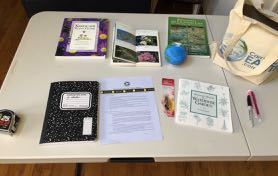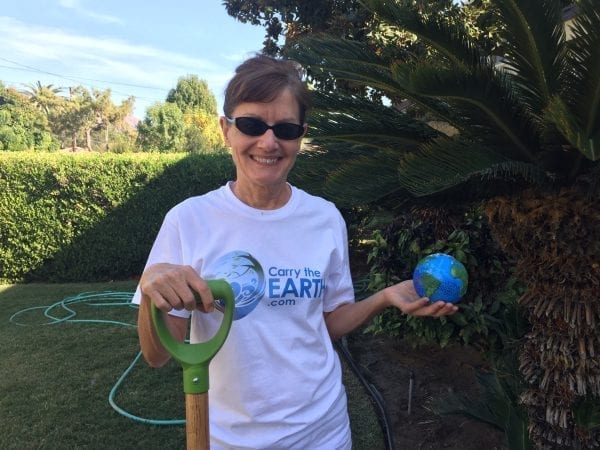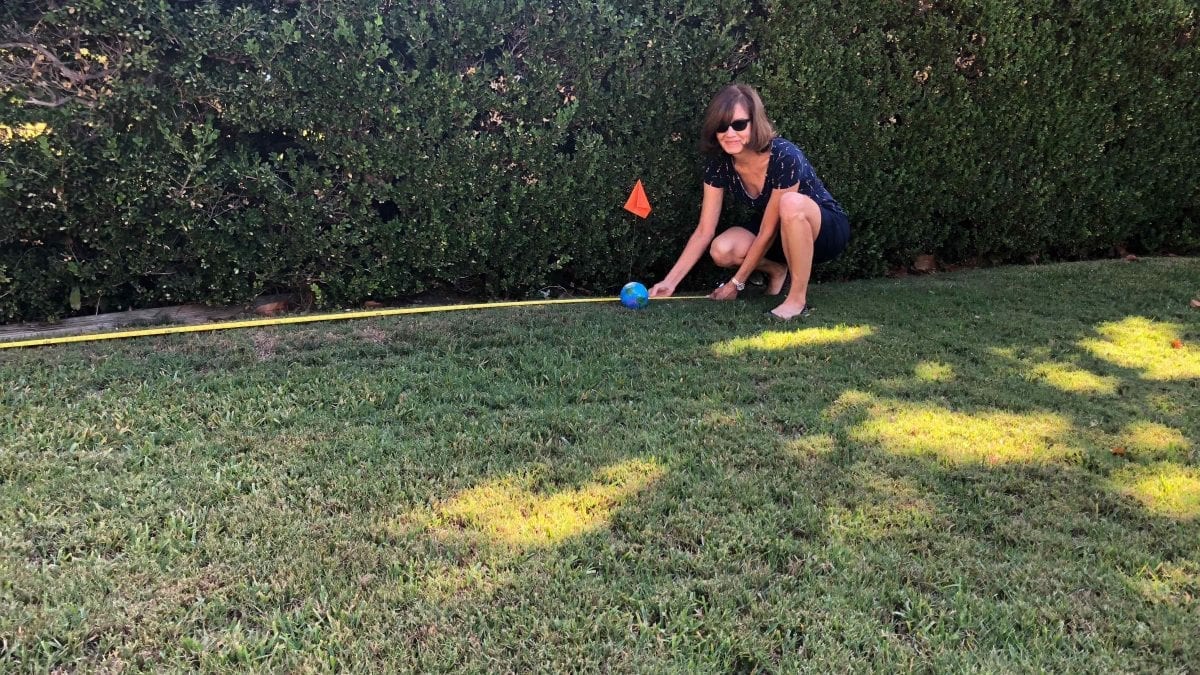- Did you receive a globe? Congratulations! Click Here for the Next Step!

The Story of Carry the EARTH
September 20, 2018
Los Angeles Environmental Education Fair
April 7, 2019Drought and Migration in California
My Carry the Earth project focuses on household water conservation beyond shorter showers and turning off the tap when scrubbing dishes etc. It has brought me to develop a 2-phased approach to replace a thirsty landscape in my front-yard. The motivation to transform the landscape dovetailed with the events described below and a break in a sprinkler pipe used for irrigation. Coincidence? Maybe, but it made me think about reducing water used for home irrigation and the next chapter in the story of my house. Living in California since the 1980’s, drought has increasingly become a threat not just to agriculture and urban communities, but also for animal habitat. Resource management increasingly comes under pressure with demand for clean freshwater.
A couple of relatively recent developments/events have inspired my Carry the Earth project to save water by replacing my rather typical suburban lawn with drought-tolerant native plants. First, the production of globe #3 called Migration which was inspired by animal migration. Secondly, last year in February 2017, the Oroville Dam on the Feather River in Northern California experienced what has been called an ‘incident’ stemming from what appeared to be long-term systemic failures by the California Department of Water Resources. Basically, the main spillway on the dam is a concrete chute which finally gave out under enormous pressures as strong winter storms pummeled the area. As rain water poured into Lake Oroville, engineers worked to control the rate of water released over the dam’s spillway. As the lake level rose, the unlined emergency spillway was brought into use for the first time in the history of the dam.
Oroville is a community in the Sierra foothills that dates back to the Gold Rush period in California history. I’m familiar with the area because of family ties. The dam was built in the mid-1960’s to reduce flooding in the region and serves as a major water storage facility. It also produces electricity for hundreds of thousands of CA residents. Construction of the dam dealt a blow to the migration of salmon and trout in the upper reaches of the river and necessitated building the Feather River Fish Hatchery. When properly managed, water flow from the dam can produce excellent conditions for salmon and steelhead health, migration and fishing. However, the ‘atmospheric river’ which led to the ‘incident’ at the dam became a matter of saving lives, animals and property from water and debris flow. It necessitated emergency evacuations not only from Oroville, but several communities further downstream.
As the pictures and videos of the unfolding disaster at Oroville Dam captured news headlines, I felt rather helpless. The thought about the impact this would have for so many local inhabitants, people and otherwise, in terms of habitat disruption and loss brought me to a better appreciation of water resource management and, ultimately, fish migration. I learned from a Facebook angler about damage to the fish spawning habitat in the Feather River below Oroville Dam. Apparently, attempts by state officials to coordinate the release of water from the dam with that of juvenile fish (from the hatchery) into the river was successful in March, but not in May. Apparently, more water was being conserved later in the season for use by California farms, towns and cities. Even under the best of circumstances, only a small percentage of salmon (Chinook are commonly found in the Feather River) survive to adulthood after being hatched in freshwater. The juveniles begin their migration by moving downstream into estuaries and eventually find their way into the salty waters of the Pacific Ocean, where they mature to adulthood. Then the hard work really starts as they return to their freshwater spawning grounds. Migratory fish have remarkable adaptive and navigational abilities. Chinook swim hundreds (sometimes thousands) of miles back ‘home’ in order to spawn, before dying. Normal life for migratory animals is hard enough, but after the Oroville dam incident, the spawning habitat on the Feather River was challenged by the presence of debris, inconsistent water levels and the spread of Ich (pronounced ‘ick’, a parasite). Ich lives on the bodies and in the gills of fish, which impacts their ability to breathe properly. Water conservation is critical in times of drought, but so are timely water releases from the dam so that low water flow doesn’t become consequential to the health of fish downstream. Combine low water levels in the river with rising temperatures and there’s greater likelihood that you’ll see fish with Ich. Not something you can unsee.
Before I get to my garden plan, I’d first like to acknowledge Ronnie Siegel. She’s the creator of Carry the Earth and you’ll see her picture painting many of the globes seen on this website. She’s also is a landscape architect, an artist and my good friend. She has designed many gardens, both residential and commercial, with an artistic approach that is also practical considering the ways in which the space could be used and the resources available. She’s knowledgeable in the use of California native and drought-tolerant plants in garden design. She’s worked for decades to design and build parks, gardens and landscapes that are practical and inviting spaces where pollinators, children and adults can to visit, play, explore, and gather. I’m thankful to have a garden to enjoy, especially in a marvelous climate like CA. I’m also very thankful to have a friend like Ronnie who is helping to educate me not just with the site analysis and design of my drought-tolerant garden, but also in how landscape architects see the world. In the grand scheme of things, the amount of water saved from my landscape transformation may turn out to be unimportant to fish migration in the Feather River, but maybe a few fish will be spared from death by Ich. So many other residents of Southern California have successfully transformed their gardens using drought-tolerant natives, it’s just a matter of time until the water-savings become significant. Carry the Earth started with one person’s reaction to some pretty staggering environmental issues. It started with one globe in California. There are now 25 globes all over the world. It’s inspiring to see people of all ages and walks of life take action in a common purpose and to give a little love to our shared home. That my project focuses on prioritizing residential water use in my little corner of the globe is only one step in solving a bigger problem, and that is resource availability and management for future generations. Problem-solving has to start somewhere if we’re to get anywhere. Those of us who carry the earth are but a relative few amongst billions on this planet. Many species migrate, but humans have the critical-thinking skills necessary to do positive work for the environment.
Stats (if you’re a nerd like me, or your wifi/internet connection isn’t working)
*Storm that led to the dam incident in Feb 2017 produced ~15 inches (~38 cm) of rain in the mountains surrounding Lake Oroville. That put the region on track to receive over 200% of its normal yearly rainfall.
*Early estimates of repair costs to the dam’s main spillway were $100-200 million, but actual costs exceeded $1 billion.
*Oroville Dam took over 5 years to build and was completed in 1967 using ~80 million cubic yards (~60 million cubic meters) of earthen material. It’s the tallest dam in America at ~770 feet (~231 m). The spillway is ~3000 feet (~900 m) in length.
*Lake Oroville is man-made as it sits behind Oroville Dam. It has a maximum depth of 695 feet (~210 m) the dam has a maximum capacity of 3.5 million acre-feet of water. I’ve no idea why an acre-foot is still a unit of measurement, but I digress; it’s the volume of water that would cover 1 square acre of land to a depth of 1 foot. That’s equivalent to 4320 billion cubic meters (~4.3 cubic km) of water. To put that in a more kid-friendly/relatable way, that’s enough water to fill 760 billion soccer balls. If that’s not mind blowing enough, a quick google search reports that 40 million soccer balls are produced each year. At that rate, it would take over 19,000 years to make enough soccer balls to hold all the water at maximum capacity behind the dam.
*The maximum discharge capacity (release rate) is 250,000 cubic feet per second (~7,100 cubic meters per sec). That would be like drinking ~2 million gallons of water every second (~7 million liters per second). Don’t try this at home…as if!
*Every day, the Hyatt Power Plant at the Oroville Dam converts enough energy from stored water into electrical energy to power over 200,000 single-family homes. http://www.lakeoroville.net/f-a-q.htm
*The Feather River Hatchery estimates that approximately 15 million eggs are collected from females in the fall. The eggs are fertilized and the hatched salmon are released as juveniles in spring. Over 50,000 adult fish return each year. Only about 2% of salmon will survive to adulthood. https://www.wildlife.ca.gov/Fishing/Hatcheries/Feather-River
My Garden and Water-Savings Plan
To help educate myself, I took a couple of classes at the Theodore Payne Foundation for Wild Flowers and Native Plants in Sun Valley, CA. I’ve read Reimagining the California Lawn by Carol Borenstein, David Fross and Bart O’Brien. I’ve also benefitted from reading Xeriscape Plant Guide by Denver Water and the American Water Works Association, Water-Saving Gardening based on Taylor’s Encyclopedia of Gardening and
by Kevin Connelly. There are a lot of websites with water-wise garden information including:
https://drinktap.org/Water-Info/Water-Conservation/Drought
WUCOLS = Water Use Classifications of Landscape Species v.III (2000) =>
https://cimis.water.ca.gov/Content/PDF/wucols00.pdf [updated v. IV 2014]
http://www.bewaterwise.com/new-landscape-transformation-program.html
https://www.huntington.org/california-garden
YouTube – for lawn removal tips and techniques if you like DIY projects.
Phase 1 – Design & Planning
The first phase of the plan is to design a garden using drought-tolerant plants that complement the style of my house and significantly reduces water use in the front yard. The goal is for the space to feel like a meandering meadow that not only offers a place for neighbors and guests to sit and talk, maybe enjoy a glass of wine, but also for pollinators to visit. I’d like the house and garden to feel connected through the selection of plant color to inclusion of rock like the stone facade on the exterior of my home. Soft grasses and flowering plants which attract birds and bees will punctuate the hardscape. While that sounds nice and tranquil, that leads to phase 2, the actual physical transformation of the landscape. That process will initially involve the death and removal of about 1000 square feet of lawn and moving or destroying several mature plants/trees. Are there ‘orphanages’ for plants you no longer want?
An initial site analysis involved measuring and assessing the following: 1) compass heading from the front yard, 2) dimensions to determine the area involved, 3) soil type and infiltration rate, and 4) sun and shade provided by structures and neighboring hedges and trees. Using the past year of water bills, I estimated the average annual water usage and projected water savings with the new landscape. Phase I also included making a time line from when new plants had the best opportunity for survival to when was the best time to remove St Augustine lawn. Without getting into specific hydrozones, evapotranspiration rates, landscape coefficient factors, irrigation efficiency etc., the good news is that, in my location, I can expect the new drought tolerant garden to use 3-4 times less water than the current landscape. This is based on the low water use plants selected and drip irrigation being more efficient as a water delivery system compared to the current pop-up sprinklers.
If you’re considering a landscape transformation project like this and you’re a novice like me, find knowledgeable assistance. It’s been my experience in life, that good intentions do not set the conditions for a satisfactory outcome. This project will take an investment not just of money, but also time, energy and commitment. I don’t want it to fail because I didn’t consider plant density, invasiveness or microclimates. It’s huge to have Ronnie’s guidance, help and support. Without that, I’d still be puzzling over charts, formulas and plant lists.

School is in!

I thought I was done with homework…not so much!
Phase 2 – Landscape Transformation
There is a window of 4-6 months between killing, removing the lawn and other existing plants to installing drip irrigation and drought-tolerant plants. The optimal time for planting here in the southwest US is in the fall (October/November) when temperatures reliably start to drop from summer highs that can reach 100+°F (38+°C). From fall through spring, absorbed landscape water will coax the plant root ball to grow deeper, thereby, becoming hardy against future seasons of summer heat. The time line involves overlap of turf removal with the rebate period (http://www.bewaterwise.com/new-landscape-transformation-program.html) for completion of landscape transformation. I will list the plant species chosen for this project after phase 2 has been completed.
By the time this project is finished, globe #3 will have moved beyond my hands and millions of fish will have hatched and died after returning to their spawning ground below Oroville Dam. Replacement of the ‘fatigued’ spillway on the dam was recently completed – just in time to beat the first significant winter rains of 2018. It was a major feat for engineering and construction teams. Considering those migratory animals that depend upon it, I hope the health of the river habitat below the dam continues to be a priority for California water resource management teams/agencies. It’s one relatively small area that illustrates a larger point. Water resource management is one of the most important issues facing California as the population increases on top of years of drought. Historically, humans have proven to be clever enough to survive and thrive. We’ve pushed into remote areas to find new resources and/or flee environmental challenges. In areas with competing fresh water needs for food production, irrigation, drinking and recreation etc., I hope we’re not too fatigued to apply our unique critical thinking skills and see the power that we hold when the earth is in our hands.

Once this project is shovel ready, I won’t need a gym membership!

